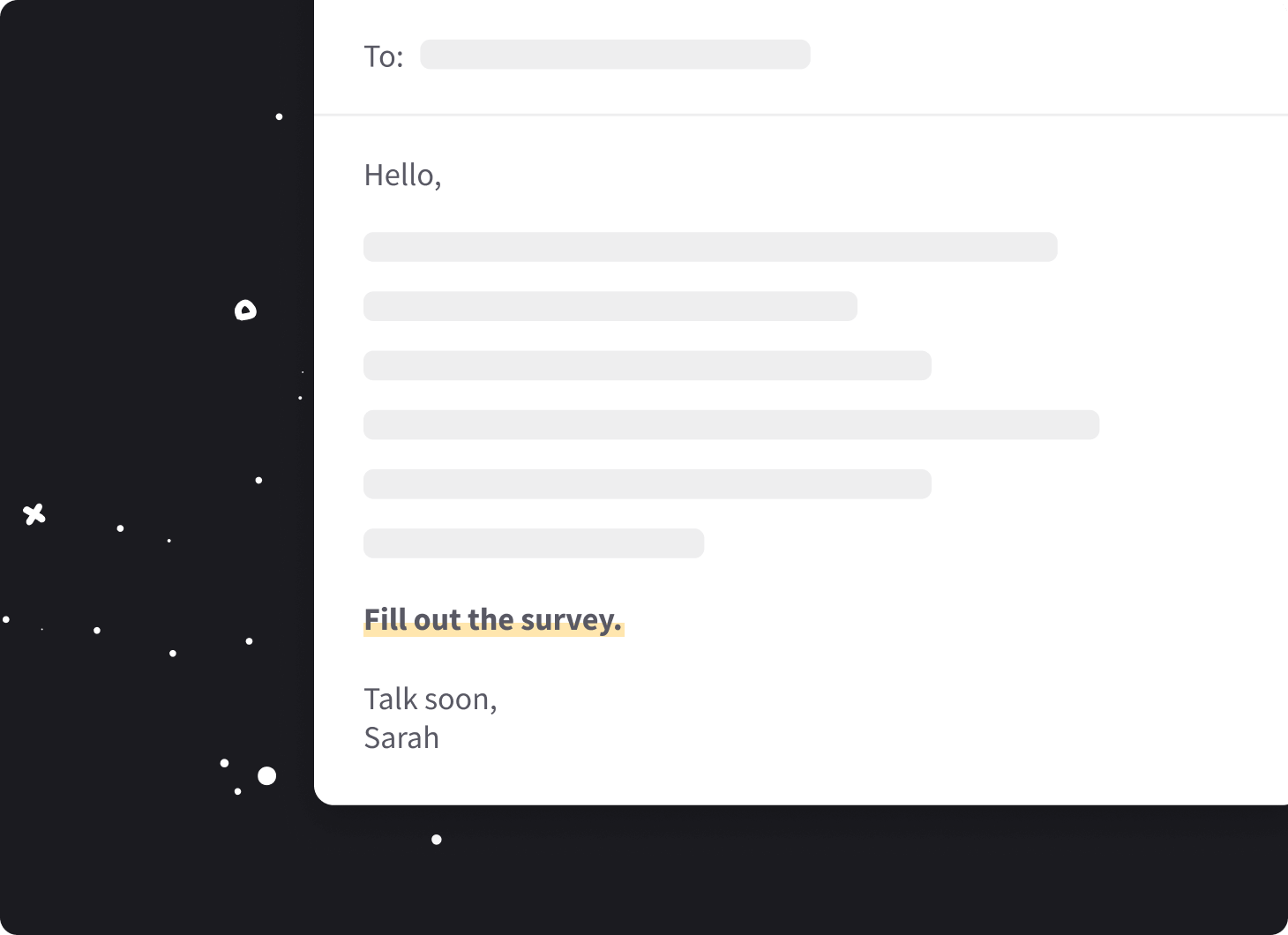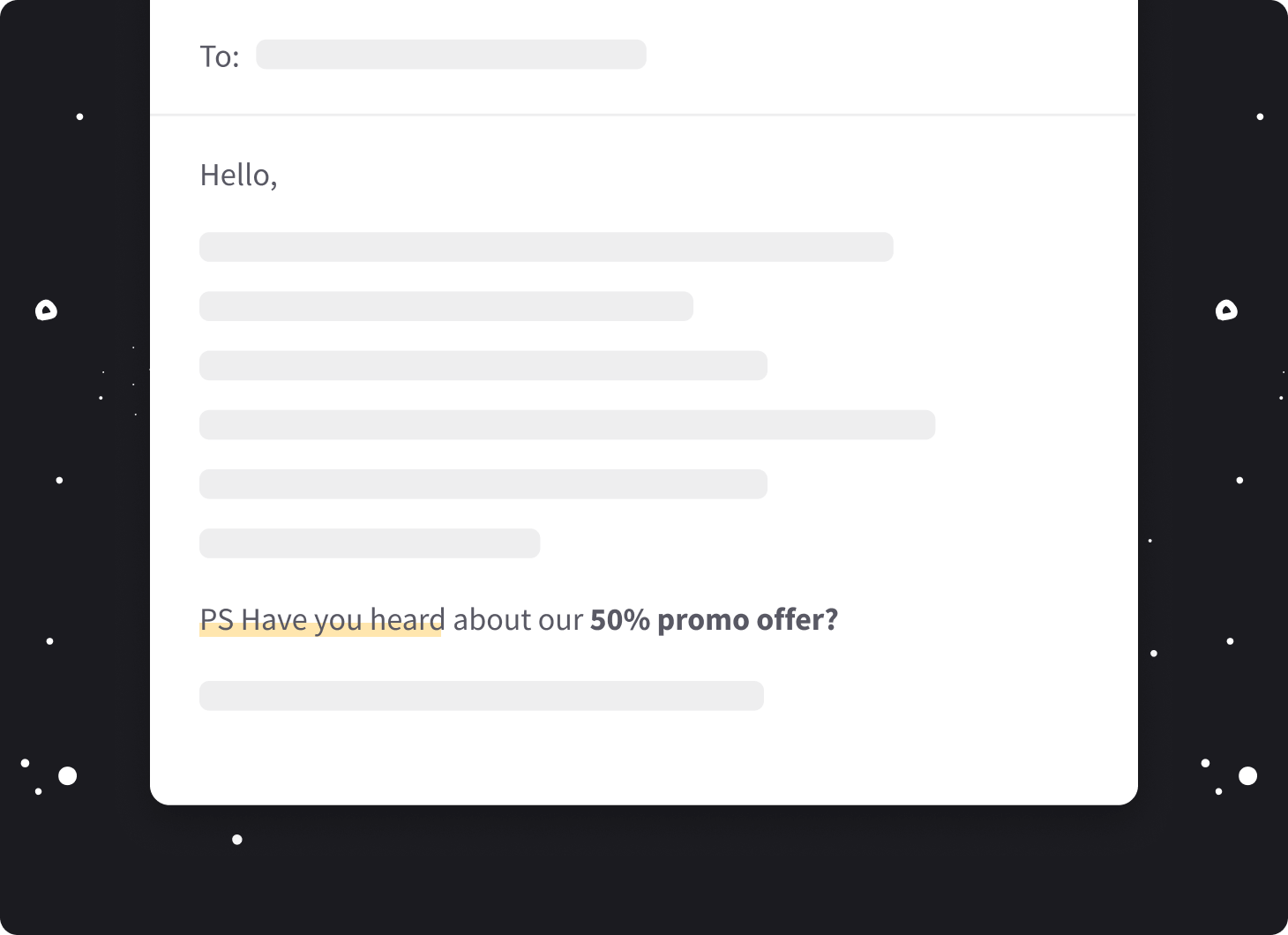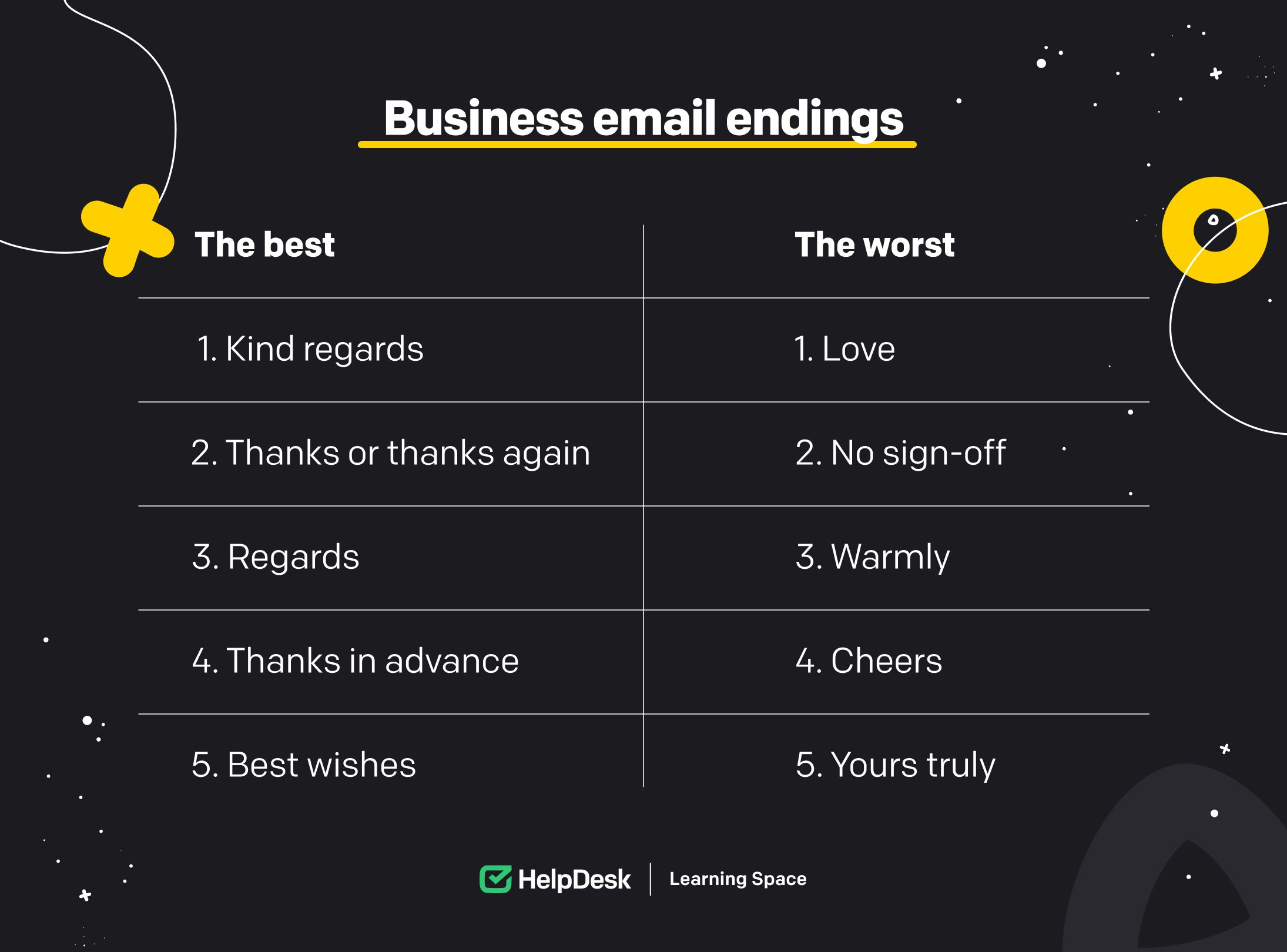


Busy supporting customers? Not anymore.
Watch hands-on webinar on workflows and easily automate your work in just five minutes!
The most important tip is to close an email with an actionable sentence. I mean crafting an ending that will encourage the reader to do something specific, be it answers a question, open your application, read an article, go to your offer, or whatever else you want to encourage them to do.
You already know how to create an efficient email structure and how to start an email. Let’s look at the best email sign-offs and find out how to end a business email to achieve your goal.
The ending is an integral part of any email communication. Due to the different aspects, you can touch on in the message body, the email closing can leave a positive impression. First, a proper ending makes it clear where your message ends. Without it, the user feels like something is missing.
Ending your email message motivates the recipient to take action, indicates your intentions, and provides information about how you perceive your relationship with the recipient. If you want to learn how to sign a business email properly, let’s stick to these five tips, and you’ll never have this dilemma again.
It really matters how you end your business email when you contact a customer, a company, or a friend. When it comes to formal communication style, don’t shorten the distance between you and the recipient if you’re unsure how they can perceive it. Choose a “safer” email closing that won’t put your reputation at risk.
However, in informal communication, you can let yourself go and be chatty and use colloquial phrases. Of course, keep in mind the type of relationship you have with your recipient. Don’t go too far with slang or other confusing words.
Jump to the list with the best email closings and match one of them to your style.
Being actionable is necessary for any form of communication. Giving the recipient a clear indicator of what to do next is the best way to achieve the desired outcome.

Close your email with one specific question or action that the recipient should take. Posing too many questions or steps to complete is a recipe for overwhelming the reader. Decide what the most crucial action is. It’ll make your conversation more dynamic without any unnecessary information.
Not everyone will do what you want them to, but the goal here is not to achieve a perfect result. The goal is to maximize your chances using what you know about user behavior.
CALL-TO-ACTION EXAMPLES |
|---|
|
Many emails you receive are closed with a vague “what do you think?” or “when would be best for you to meet?”. Although the intentions here are clearly good and indicate a high level of writer’s empathy (“I value your time and opinion”), it’s not the best way to end an email.

Be specific and include a proposed time for the meeting. Suppose you’re establishing the project timeframe with a coworker, set up a deadline. Skip the ASAP part, and make sure that whatever you’re working on will be well taken care of. Don’t forget to make this deadline sound like a proposal, not an order.
An email signature allows you to add links to social media or your website. To see if anyone clicks the link in your signature, add UTMs to these links. Additional data is always useful when it comes to analyzing traffic sources.
IDEAS OF RESOURCES TO LINK IN YOUR EMAIL SIGNATURE: |
|---|
|
Fancy signatures with photos and brand logos are more appropriate for marketing emails. I’d stick to a simple text signature with a link or two to relevant pages for regular business correspondence. Signatures say more about who you’re and what you offer, so you should customize the signature to your situation and email campaign.
Before sending any message to a customer, be sure to add a proper signature. You can greatly increase your credibility with this little detail. Sign up to HelpDesk if you want your message to look professional every time.
Adding a P.S. (postscript), which comes from post scriptum (“written after”), is Latin for a way of adding “one more thing” before moving on to whatever you’re doing.
There’s no definite grammar rule to write PS versus P.S. The version with periods appears more in American English, but it’s not a definitive rule. Simple P.S. works anytime.
Indeed, the P.S. lines have proved effective in marketing emails. Should you use P.S. in formal email as well? It depends on the goal of your message, and here are the examples:
If you’re writing a job application or contacting a potential business partner with whom you already have a relationship, I’d advise you to skip it. Try to include all the information in the main body of the email message, that way, you show that it was well-thought-out, and you didn’t forget anything that you would need to include in the P.S. as a result.
If you’re cold-emailing, pitching offers, or doing any activity with a lower response probability, then go ahead and use P.S, it’s acceptable here. The copy you include in P.S. can be conversational, interesting, and catchy. It can point to something the recipient should know about before leaving or be a “gentle reminder.” P.S. can make your formal email more engaging.
Also, remember that research shows readers tend to read the P.S. first. If you use this language device, use it with caution.

Go ahead and try a P.S. in your formal email communication. Let us know if it works for your prospects.
There are many common expressions that people use daily to end an email. Some of them are more effective, others less so. The good news is that this topic has recently been more deeply explored, and it’s eye-opening. The Perkbox Insights’s survey of nearly 2,000 people shows exactly what the five best and five worst business email endings are.

The results can come as a surprise to you. They definitely can create some confusion among communications, marketing, sales, and customer service professionals. Keep in mind that it’s a very individual thing, and some companies have a tone of voice that allows them to use “cheers” or “warmly” in their communication. You can see for yourself that this is risky if you don’t know exactly who you’re dealing with on the other end.
According to the survey mentioned earlier, 15% of people spend more than five hours checking and sending emails each day. That’s a lot! So, make sure that every interaction your recipient has with your email ends up as a positive experience.
If you’re wondering how to end an email, this list will be of help. Check these email closing phrases. Choose one of them, then copy & paste it to your email message.
Once you’ve written the entire body of the email that will be sent to the customer, the obvious next step is to end the email. Just before you send the email, you can use one sentence to gently refer to the email subject, such as expressing your expectation for further conversation or curiosity about how the customer perceives the proposed offer. The email ending is the place to be kind and clearly emphasize what you particularly care about. Here are the most polite ways to end an email to a customer.
HOW TO END AN EMAIL TO A CUSTOMER |
|---|
Sincerely |
Cordially |
Please let me know if you have any questions |
Please let me know if you need anything |
If you want to know more, I'll be happy to help you |
Always happy to hear from you |
With appreciation |
With gratitude |
Respectfully |
If you require any assistance, feel free to contact me |
Please write to me if you encounter any problems |
I look forward to hearing from you |
When you write an email to a company, always think about the impression you want to make. Do you want to be seen as confident and strong-willed? Or maybe you want to show distance and a cool-headed approach? Writing clear business emails can help you position yourself positively in your career, professional network, or relationship with a potential employer. The same goes for the ending of your email to the company. Choose the right email sign-off from the list to show your attitude.
HOW TO END AN EMAIL TO A COMPANY |
|---|
Sincerely |
Cordially |
Yours sincerely |
Best regards |
Warm regards |
Kind regards |
With appreciation |
With gratitude |
Respectfully |
I appreciate your feedback |
Thank you in advance |
Thank you for your time |
Current best practices related to the recruitment process dictate that you should thank them for their time after a fruitful conversation with a recruiter. By doing so, you’ll make the recruiter remember you, which will bring you closer to employment opportunity. Choose one of the following endings for an email to the recruiter to get your dream job.
HOW TO END AN EMAIL TO A RECRUITER |
|---|
Sincerely |
Cordially |
Yours sincerely |
Yours faithfully |
Appreciate your time and consideration |
I'd appreciate your response |
I’d really appreciate your feedback |
With appreciation |
Respectfully |
Thank you for your time |
Thank you in advance |
Thank you for your time |
Messages to friends are always full of exciting stories, confessions, friendly questions, or memories. It’s an excellent idea to end such an interaction with an appropriate email ending. Find the right tone to close your email to the friend. Here’s the list with the best sign-offs that you can use to end an email to a friend.
HOW TO END AN EMAIL TO A FRIEND |
|---|
Have a great day/week/weekend |
Cheers |
Later |
See you soon |
Until next time |
Looking forward to hearing from you |
Write to you soon |
Speak to you soon |
Yours truly |
Your friend |
Yours |
Take care |
Best wishes |
Wishing you a wonderful day |
Contact with a person who’s a stranger to you always brings up a range of emotions. However, remember that everyone deserves respect. When writing a message to a person you don’t really know well, use the universal phrases to not fall into the communication trap. The same goes for ending your email, so try one of the suggestions below to come out on top and end an email to a stranger the right way.
HOW TO END AN EMAIL TO A STRANGER |
|---|
Sincerely |
Cordially |
Thank you |
Many thanks |
Best regards |
Warm regards |
Kind regards |
With appreciation |
With gratitude |
Now you know how to end a professional email effectively. Some tips work better for standard correspondence, and others are more aimed at sending offers or contacting someone for the first time. How you end your email matters. Research indicates that there’s a correlation between email sign-offs and reply rates. It’s not only about the style but also about optimizing your results. There are several takeaways on how to end an email professionally:
Choose how to end your email based on the relationship you have with the recipient.
Remember to include a call to action.
Be specific and set up a deadline for the expected action.
Use signatures to your advantage.
Keep track of the links you included with UTM parameters.
Use a P.S. line to catch recipients’ attention.
In the next lesson
The Importance of a Follow-Up Email
Learn what are follow-up emails and why you should send them. This class is designed in partnership with Keap.
Go to lesson 4Subscription with a gift!
Join the mailing list to get a special ebook on email communication.
Try HelpDesk for free
For quick and intuitive tickets management